Understanding Business Organizations: Types, Structures, and Culture
VerifiedAdded on 2023/06/04
|7
|1777
|278
Report
AI Summary
This report provides a detailed analysis of business organizations, covering various aspects such as types, structures, functions, and organizational culture. It begins by defining businesses and highlighting the importance of understanding them for success. The report then explores different types of business entities, including sole proprietorships, partnerships, and corporations, along with their advantages and disadvantages. It also compares tall and flat organizational structures, discussing their respective benefits and drawbacks. Furthermore, the report examines key business functions like HR, sales, operations, marketing, and finance, explaining their roles and impact on company activities. Finally, it defines organizational culture and its positive influence on a firm's success, emphasizing the importance of a good work environment. The report references several academic sources to support its findings and concludes with a summary of the key takeaways.
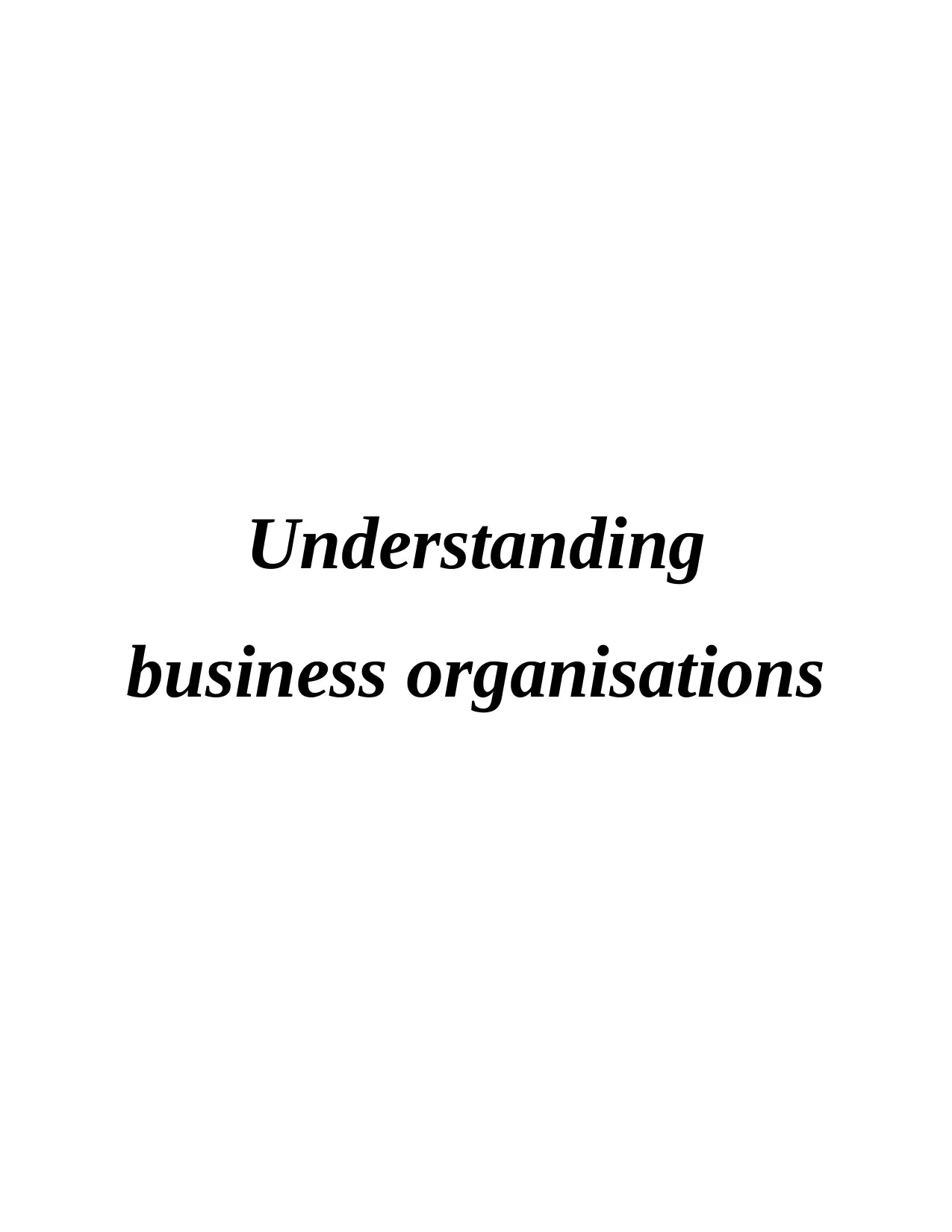
Understanding
business organisations
business organisations
Paraphrase This Document
Need a fresh take? Get an instant paraphrase of this document with our AI Paraphraser
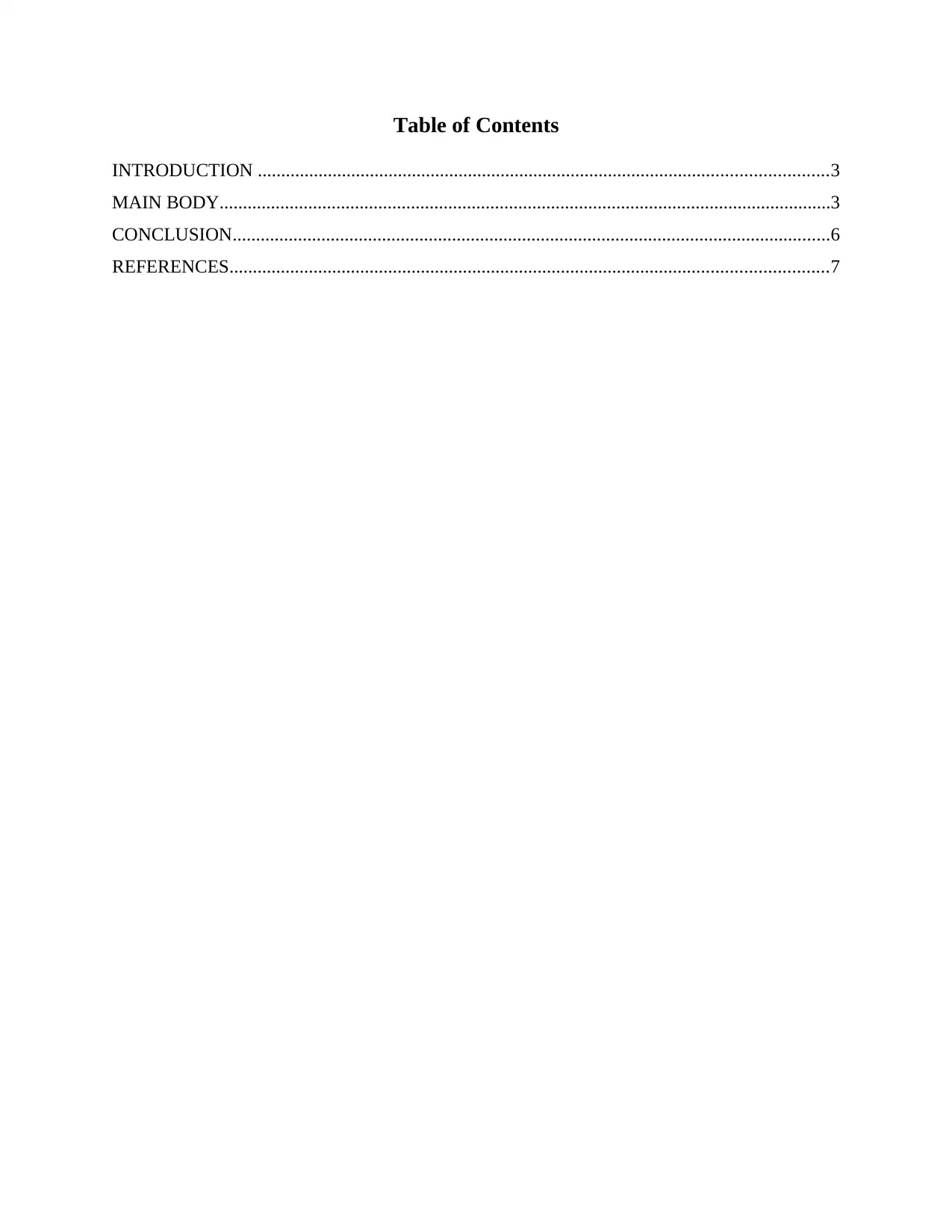
Table of Contents
INTRODUCTION ..........................................................................................................................3
MAIN BODY...................................................................................................................................3
CONCLUSION................................................................................................................................6
REFERENCES................................................................................................................................7
INTRODUCTION ..........................................................................................................................3
MAIN BODY...................................................................................................................................3
CONCLUSION................................................................................................................................6
REFERENCES................................................................................................................................7
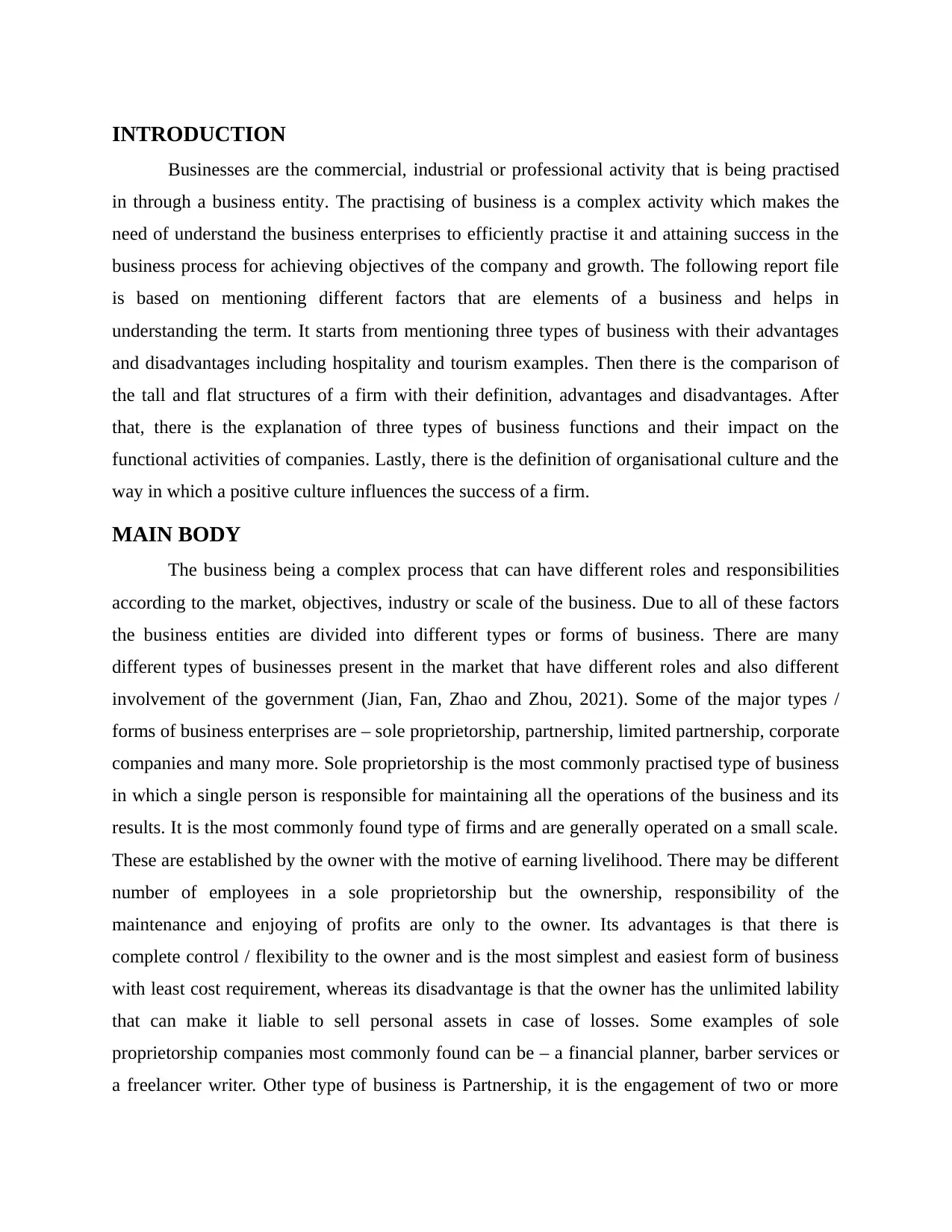
INTRODUCTION
Businesses are the commercial, industrial or professional activity that is being practised
in through a business entity. The practising of business is a complex activity which makes the
need of understand the business enterprises to efficiently practise it and attaining success in the
business process for achieving objectives of the company and growth. The following report file
is based on mentioning different factors that are elements of a business and helps in
understanding the term. It starts from mentioning three types of business with their advantages
and disadvantages including hospitality and tourism examples. Then there is the comparison of
the tall and flat structures of a firm with their definition, advantages and disadvantages. After
that, there is the explanation of three types of business functions and their impact on the
functional activities of companies. Lastly, there is the definition of organisational culture and the
way in which a positive culture influences the success of a firm.
MAIN BODY
The business being a complex process that can have different roles and responsibilities
according to the market, objectives, industry or scale of the business. Due to all of these factors
the business entities are divided into different types or forms of business. There are many
different types of businesses present in the market that have different roles and also different
involvement of the government (Jian, Fan, Zhao and Zhou, 2021). Some of the major types /
forms of business enterprises are – sole proprietorship, partnership, limited partnership, corporate
companies and many more. Sole proprietorship is the most commonly practised type of business
in which a single person is responsible for maintaining all the operations of the business and its
results. It is the most commonly found type of firms and are generally operated on a small scale.
These are established by the owner with the motive of earning livelihood. There may be different
number of employees in a sole proprietorship but the ownership, responsibility of the
maintenance and enjoying of profits are only to the owner. Its advantages is that there is
complete control / flexibility to the owner and is the most simplest and easiest form of business
with least cost requirement, whereas its disadvantage is that the owner has the unlimited lability
that can make it liable to sell personal assets in case of losses. Some examples of sole
proprietorship companies most commonly found can be – a financial planner, barber services or
a freelancer writer. Other type of business is Partnership, it is the engagement of two or more
Businesses are the commercial, industrial or professional activity that is being practised
in through a business entity. The practising of business is a complex activity which makes the
need of understand the business enterprises to efficiently practise it and attaining success in the
business process for achieving objectives of the company and growth. The following report file
is based on mentioning different factors that are elements of a business and helps in
understanding the term. It starts from mentioning three types of business with their advantages
and disadvantages including hospitality and tourism examples. Then there is the comparison of
the tall and flat structures of a firm with their definition, advantages and disadvantages. After
that, there is the explanation of three types of business functions and their impact on the
functional activities of companies. Lastly, there is the definition of organisational culture and the
way in which a positive culture influences the success of a firm.
MAIN BODY
The business being a complex process that can have different roles and responsibilities
according to the market, objectives, industry or scale of the business. Due to all of these factors
the business entities are divided into different types or forms of business. There are many
different types of businesses present in the market that have different roles and also different
involvement of the government (Jian, Fan, Zhao and Zhou, 2021). Some of the major types /
forms of business enterprises are – sole proprietorship, partnership, limited partnership, corporate
companies and many more. Sole proprietorship is the most commonly practised type of business
in which a single person is responsible for maintaining all the operations of the business and its
results. It is the most commonly found type of firms and are generally operated on a small scale.
These are established by the owner with the motive of earning livelihood. There may be different
number of employees in a sole proprietorship but the ownership, responsibility of the
maintenance and enjoying of profits are only to the owner. Its advantages is that there is
complete control / flexibility to the owner and is the most simplest and easiest form of business
with least cost requirement, whereas its disadvantage is that the owner has the unlimited lability
that can make it liable to sell personal assets in case of losses. Some examples of sole
proprietorship companies most commonly found can be – a financial planner, barber services or
a freelancer writer. Other type of business is Partnership, it is the engagement of two or more
⊘ This is a preview!⊘
Do you want full access?
Subscribe today to unlock all pages.

Trusted by 1+ million students worldwide
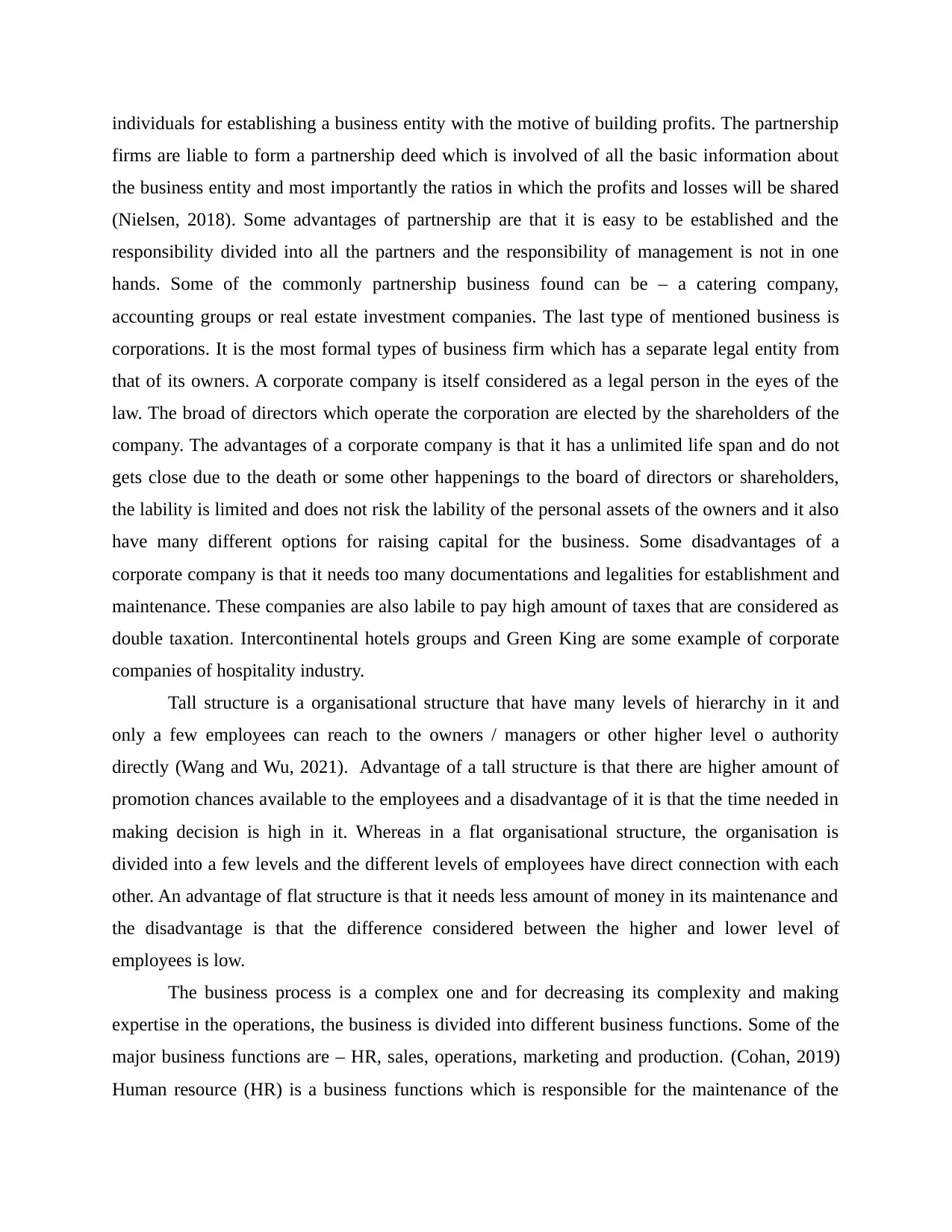
individuals for establishing a business entity with the motive of building profits. The partnership
firms are liable to form a partnership deed which is involved of all the basic information about
the business entity and most importantly the ratios in which the profits and losses will be shared
(Nielsen, 2018). Some advantages of partnership are that it is easy to be established and the
responsibility divided into all the partners and the responsibility of management is not in one
hands. Some of the commonly partnership business found can be – a catering company,
accounting groups or real estate investment companies. The last type of mentioned business is
corporations. It is the most formal types of business firm which has a separate legal entity from
that of its owners. A corporate company is itself considered as a legal person in the eyes of the
law. The broad of directors which operate the corporation are elected by the shareholders of the
company. The advantages of a corporate company is that it has a unlimited life span and do not
gets close due to the death or some other happenings to the board of directors or shareholders,
the lability is limited and does not risk the lability of the personal assets of the owners and it also
have many different options for raising capital for the business. Some disadvantages of a
corporate company is that it needs too many documentations and legalities for establishment and
maintenance. These companies are also labile to pay high amount of taxes that are considered as
double taxation. Intercontinental hotels groups and Green King are some example of corporate
companies of hospitality industry.
Tall structure is a organisational structure that have many levels of hierarchy in it and
only a few employees can reach to the owners / managers or other higher level o authority
directly (Wang and Wu, 2021). Advantage of a tall structure is that there are higher amount of
promotion chances available to the employees and a disadvantage of it is that the time needed in
making decision is high in it. Whereas in a flat organisational structure, the organisation is
divided into a few levels and the different levels of employees have direct connection with each
other. An advantage of flat structure is that it needs less amount of money in its maintenance and
the disadvantage is that the difference considered between the higher and lower level of
employees is low.
The business process is a complex one and for decreasing its complexity and making
expertise in the operations, the business is divided into different business functions. Some of the
major business functions are – HR, sales, operations, marketing and production. (Cohan, 2019)
Human resource (HR) is a business functions which is responsible for the maintenance of the
firms are liable to form a partnership deed which is involved of all the basic information about
the business entity and most importantly the ratios in which the profits and losses will be shared
(Nielsen, 2018). Some advantages of partnership are that it is easy to be established and the
responsibility divided into all the partners and the responsibility of management is not in one
hands. Some of the commonly partnership business found can be – a catering company,
accounting groups or real estate investment companies. The last type of mentioned business is
corporations. It is the most formal types of business firm which has a separate legal entity from
that of its owners. A corporate company is itself considered as a legal person in the eyes of the
law. The broad of directors which operate the corporation are elected by the shareholders of the
company. The advantages of a corporate company is that it has a unlimited life span and do not
gets close due to the death or some other happenings to the board of directors or shareholders,
the lability is limited and does not risk the lability of the personal assets of the owners and it also
have many different options for raising capital for the business. Some disadvantages of a
corporate company is that it needs too many documentations and legalities for establishment and
maintenance. These companies are also labile to pay high amount of taxes that are considered as
double taxation. Intercontinental hotels groups and Green King are some example of corporate
companies of hospitality industry.
Tall structure is a organisational structure that have many levels of hierarchy in it and
only a few employees can reach to the owners / managers or other higher level o authority
directly (Wang and Wu, 2021). Advantage of a tall structure is that there are higher amount of
promotion chances available to the employees and a disadvantage of it is that the time needed in
making decision is high in it. Whereas in a flat organisational structure, the organisation is
divided into a few levels and the different levels of employees have direct connection with each
other. An advantage of flat structure is that it needs less amount of money in its maintenance and
the disadvantage is that the difference considered between the higher and lower level of
employees is low.
The business process is a complex one and for decreasing its complexity and making
expertise in the operations, the business is divided into different business functions. Some of the
major business functions are – HR, sales, operations, marketing and production. (Cohan, 2019)
Human resource (HR) is a business functions which is responsible for the maintenance of the
Paraphrase This Document
Need a fresh take? Get an instant paraphrase of this document with our AI Paraphraser
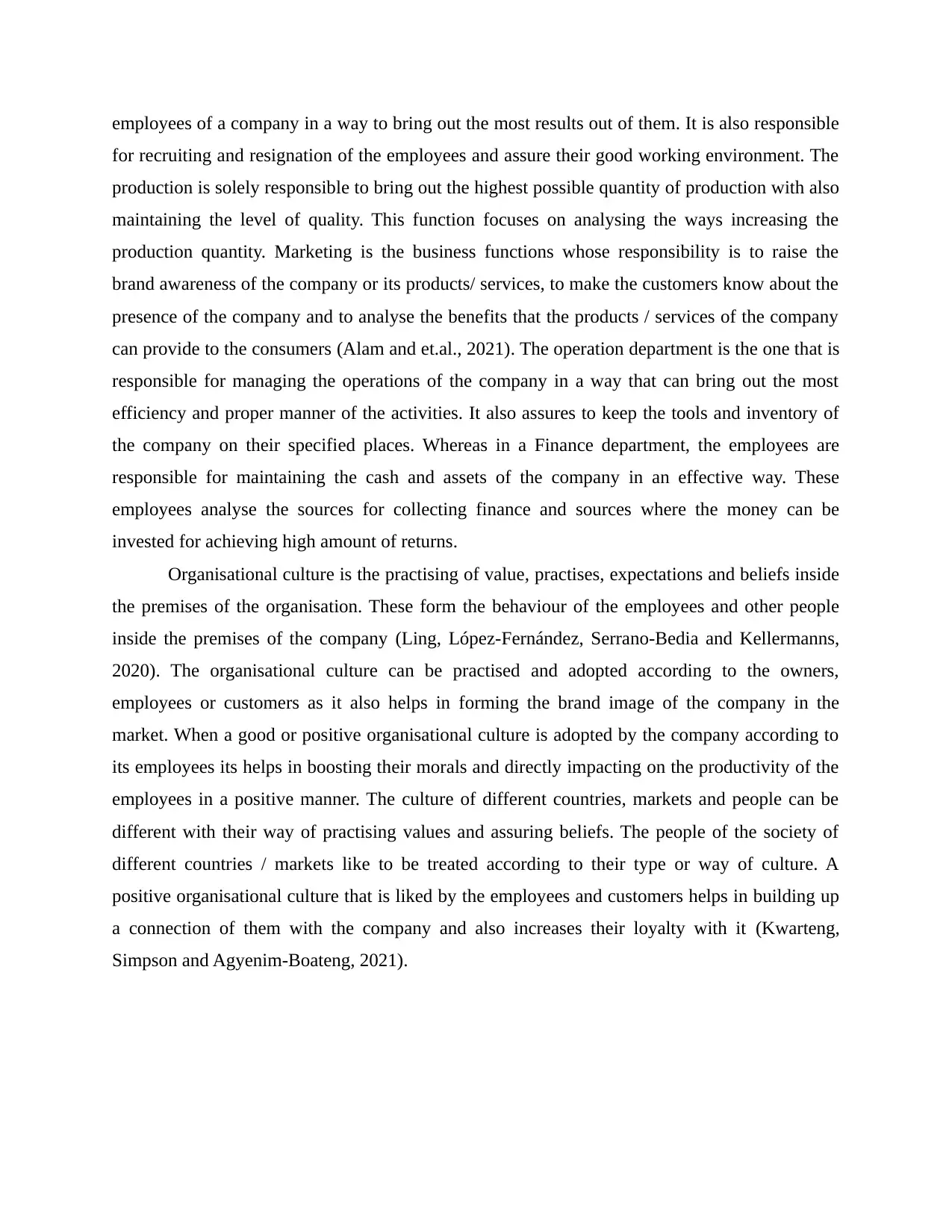
employees of a company in a way to bring out the most results out of them. It is also responsible
for recruiting and resignation of the employees and assure their good working environment. The
production is solely responsible to bring out the highest possible quantity of production with also
maintaining the level of quality. This function focuses on analysing the ways increasing the
production quantity. Marketing is the business functions whose responsibility is to raise the
brand awareness of the company or its products/ services, to make the customers know about the
presence of the company and to analyse the benefits that the products / services of the company
can provide to the consumers (Alam and et.al., 2021). The operation department is the one that is
responsible for managing the operations of the company in a way that can bring out the most
efficiency and proper manner of the activities. It also assures to keep the tools and inventory of
the company on their specified places. Whereas in a Finance department, the employees are
responsible for maintaining the cash and assets of the company in an effective way. These
employees analyse the sources for collecting finance and sources where the money can be
invested for achieving high amount of returns.
Organisational culture is the practising of value, practises, expectations and beliefs inside
the premises of the organisation. These form the behaviour of the employees and other people
inside the premises of the company (Ling, López-Fernández, Serrano-Bedia and Kellermanns,
2020). The organisational culture can be practised and adopted according to the owners,
employees or customers as it also helps in forming the brand image of the company in the
market. When a good or positive organisational culture is adopted by the company according to
its employees its helps in boosting their morals and directly impacting on the productivity of the
employees in a positive manner. The culture of different countries, markets and people can be
different with their way of practising values and assuring beliefs. The people of the society of
different countries / markets like to be treated according to their type or way of culture. A
positive organisational culture that is liked by the employees and customers helps in building up
a connection of them with the company and also increases their loyalty with it (Kwarteng,
Simpson and Agyenim-Boateng, 2021).
for recruiting and resignation of the employees and assure their good working environment. The
production is solely responsible to bring out the highest possible quantity of production with also
maintaining the level of quality. This function focuses on analysing the ways increasing the
production quantity. Marketing is the business functions whose responsibility is to raise the
brand awareness of the company or its products/ services, to make the customers know about the
presence of the company and to analyse the benefits that the products / services of the company
can provide to the consumers (Alam and et.al., 2021). The operation department is the one that is
responsible for managing the operations of the company in a way that can bring out the most
efficiency and proper manner of the activities. It also assures to keep the tools and inventory of
the company on their specified places. Whereas in a Finance department, the employees are
responsible for maintaining the cash and assets of the company in an effective way. These
employees analyse the sources for collecting finance and sources where the money can be
invested for achieving high amount of returns.
Organisational culture is the practising of value, practises, expectations and beliefs inside
the premises of the organisation. These form the behaviour of the employees and other people
inside the premises of the company (Ling, López-Fernández, Serrano-Bedia and Kellermanns,
2020). The organisational culture can be practised and adopted according to the owners,
employees or customers as it also helps in forming the brand image of the company in the
market. When a good or positive organisational culture is adopted by the company according to
its employees its helps in boosting their morals and directly impacting on the productivity of the
employees in a positive manner. The culture of different countries, markets and people can be
different with their way of practising values and assuring beliefs. The people of the society of
different countries / markets like to be treated according to their type or way of culture. A
positive organisational culture that is liked by the employees and customers helps in building up
a connection of them with the company and also increases their loyalty with it (Kwarteng,
Simpson and Agyenim-Boateng, 2021).
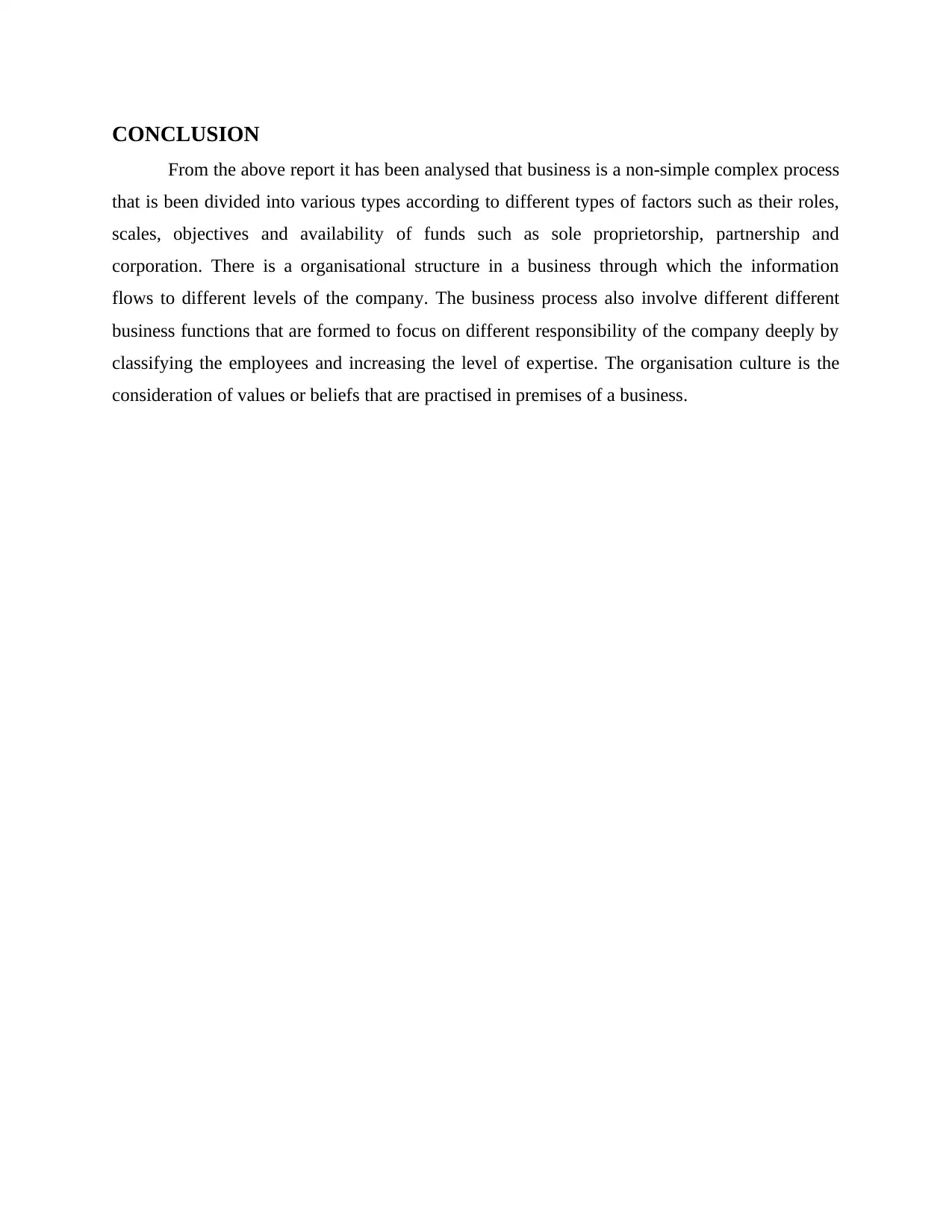
CONCLUSION
From the above report it has been analysed that business is a non-simple complex process
that is been divided into various types according to different types of factors such as their roles,
scales, objectives and availability of funds such as sole proprietorship, partnership and
corporation. There is a organisational structure in a business through which the information
flows to different levels of the company. The business process also involve different different
business functions that are formed to focus on different responsibility of the company deeply by
classifying the employees and increasing the level of expertise. The organisation culture is the
consideration of values or beliefs that are practised in premises of a business.
From the above report it has been analysed that business is a non-simple complex process
that is been divided into various types according to different types of factors such as their roles,
scales, objectives and availability of funds such as sole proprietorship, partnership and
corporation. There is a organisational structure in a business through which the information
flows to different levels of the company. The business process also involve different different
business functions that are formed to focus on different responsibility of the company deeply by
classifying the employees and increasing the level of expertise. The organisation culture is the
consideration of values or beliefs that are practised in premises of a business.
⊘ This is a preview!⊘
Do you want full access?
Subscribe today to unlock all pages.

Trusted by 1+ million students worldwide
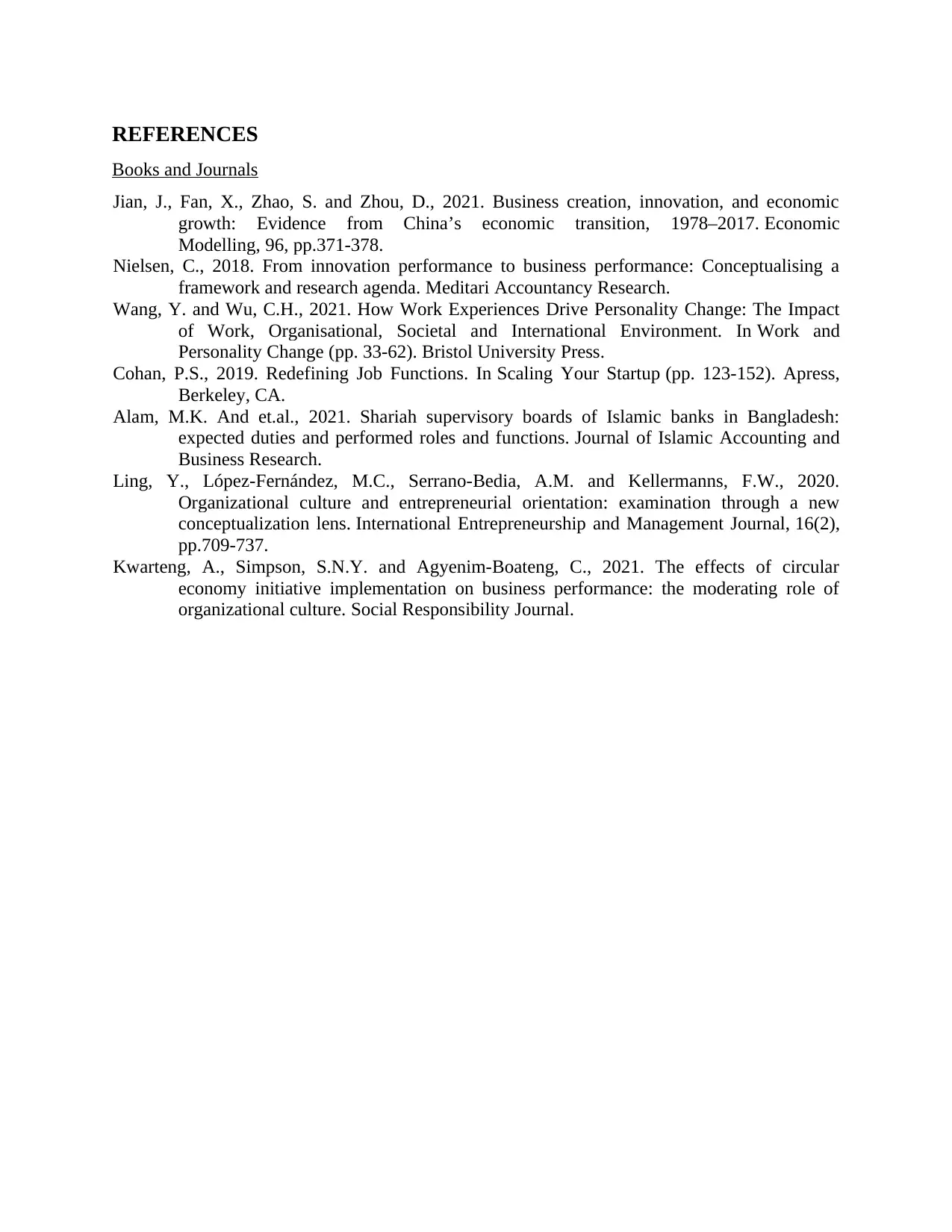
REFERENCES
Books and Journals
Jian, J., Fan, X., Zhao, S. and Zhou, D., 2021. Business creation, innovation, and economic
growth: Evidence from China’s economic transition, 1978–2017. Economic
Modelling, 96, pp.371-378.
Nielsen, C., 2018. From innovation performance to business performance: Conceptualising a
framework and research agenda. Meditari Accountancy Research.
Wang, Y. and Wu, C.H., 2021. How Work Experiences Drive Personality Change: The Impact
of Work, Organisational, Societal and International Environment. In Work and
Personality Change (pp. 33-62). Bristol University Press.
Cohan, P.S., 2019. Redefining Job Functions. In Scaling Your Startup (pp. 123-152). Apress,
Berkeley, CA.
Alam, M.K. And et.al., 2021. Shariah supervisory boards of Islamic banks in Bangladesh:
expected duties and performed roles and functions. Journal of Islamic Accounting and
Business Research.
Ling, Y., López-Fernández, M.C., Serrano-Bedia, A.M. and Kellermanns, F.W., 2020.
Organizational culture and entrepreneurial orientation: examination through a new
conceptualization lens. International Entrepreneurship and Management Journal, 16(2),
pp.709-737.
Kwarteng, A., Simpson, S.N.Y. and Agyenim-Boateng, C., 2021. The effects of circular
economy initiative implementation on business performance: the moderating role of
organizational culture. Social Responsibility Journal.
Books and Journals
Jian, J., Fan, X., Zhao, S. and Zhou, D., 2021. Business creation, innovation, and economic
growth: Evidence from China’s economic transition, 1978–2017. Economic
Modelling, 96, pp.371-378.
Nielsen, C., 2018. From innovation performance to business performance: Conceptualising a
framework and research agenda. Meditari Accountancy Research.
Wang, Y. and Wu, C.H., 2021. How Work Experiences Drive Personality Change: The Impact
of Work, Organisational, Societal and International Environment. In Work and
Personality Change (pp. 33-62). Bristol University Press.
Cohan, P.S., 2019. Redefining Job Functions. In Scaling Your Startup (pp. 123-152). Apress,
Berkeley, CA.
Alam, M.K. And et.al., 2021. Shariah supervisory boards of Islamic banks in Bangladesh:
expected duties and performed roles and functions. Journal of Islamic Accounting and
Business Research.
Ling, Y., López-Fernández, M.C., Serrano-Bedia, A.M. and Kellermanns, F.W., 2020.
Organizational culture and entrepreneurial orientation: examination through a new
conceptualization lens. International Entrepreneurship and Management Journal, 16(2),
pp.709-737.
Kwarteng, A., Simpson, S.N.Y. and Agyenim-Boateng, C., 2021. The effects of circular
economy initiative implementation on business performance: the moderating role of
organizational culture. Social Responsibility Journal.
1 out of 7
Related Documents
Your All-in-One AI-Powered Toolkit for Academic Success.
+13062052269
info@desklib.com
Available 24*7 on WhatsApp / Email
![[object Object]](/_next/static/media/star-bottom.7253800d.svg)
Unlock your academic potential
Copyright © 2020–2025 A2Z Services. All Rights Reserved. Developed and managed by ZUCOL.



